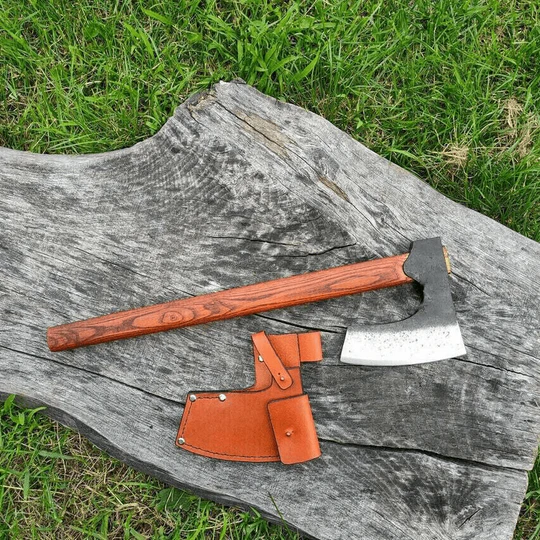The Viking war axe is one of the maximum iconic guns associated with the Norse warriors who roamed Europe from the 8th to the 11th centuries. Known for his or her seafaring prowess, the Vikings had been formidable in warfare, and their axes played a essential position in their conquests. The struggle awl became now not handiest a weapon of struggle however additionally a device utilized in day by day Viking lifestyles. This article explores the charming history, layout, and significance of Viking struggle axes, in addition to their function in Viking subculture and battle.
Battle axes were versatile, utilized in near fight, however also able to being thrown at enemies. The layout of the Viking axe allowed for effective moves that could penetrate armor, cut up shields, and supply deadly blows. Their effectiveness in fight made them feared throughout Europe.
Viking axes had been crafted with precision and talent. The blades were usually made of iron, although a few later examples used metal for greater energy and durability. The blade was connected to a wooden shaft, which could vary in length depending at the form of awl. The timber changed into normally sourced from ash or okaytrees, acknowledged for their strength and flexibility.
The blade design become curved, which allowed for deeper cuts and more efficient strikes. The thinness of the blade made it lighter, improving the velocity and maneuverability of the weapon. This was especially important in the fast-paced fight of the Viking age, where agility and pace may want to imply the distinction among lifestyles and demise.
Viking blacksmiths often decorated the blades with engravings or inlays of silver, copper, or different metals. These designs have been now not just ornamental however often held symbolic or magical significance. They reflected the cultural significance of the weapon, as well as the warrior’s reputation in Viking society.
Axes have been more than just guns to the Vikings—they have been a image of power, reputation, and background. The struggle axe, in particular, became emblematic of Viking tradition and conflict. It was frequently buried with its owner, symbolizing the warrior’s readiness for conflict inside the afterlife.
The axe became also a tool utilized in daily life, from reducing wooden to building ships and houses. This twin-reason nature gave the awl a special vicinity in Viking society, blurring the strains among warfare and day by day lifestyles. The Viking belief in destiny, braveness, and honor became tied to their guns, and the axe became taken into consideration a key part of a warrior’s identity.
In Viking war, battle axes were hired for both offense and defense. In near-sector combat, their sharp, wide blades allowed for precise strikes that might incapacitate an opponent speedy. The throwing axe turned into another innovation used by the Vikings. Warriors might hurl axes at enemies, either to motive injury or to break thru shields.
In massive-scale battles, Viking warriors might frequently form guard partitions—rows of warriors standing shoulder to shoulder with shields held tightly together. Axes were used in those formations to hook over the pinnacle of shields, placing at the enemy from at the back of cover. This tactic made Viking armies noticeably effective towards even extra closely armored foes.
The lightweight nature of many Viking axes made them versatile on the battlefield. Unlike the swords in their time, which had been reserved for wealthier warriors, the axe could be made and maintained more without problems, permitting each Viking, from not unusual squaddies to pro berserkers, to hold one.
Several well-known Viking axes are stated in historic texts and Norse sagas. One of the most remarkable is the awl of Ragnar Lodbrok, a mythical Viking king and warrior. According to the sagas, Ragnar’s axe become now not only a deadly weapon but also a symbol of his proper to rule and his prowess in war.
By the stop of the Viking Age in the 11th century, the role of the struggle axe started to say no. As European conflict advanced, new guns and armor, together with longswords and plate armor, became more outstanding. The warfare axe, whilst nevertheless effective, changed into increasingly more replaced by way of extra superior weaponry applicable to changing navy processes.
The Viking battle axe has remained a symbol of power, aggression, and warrior culture in current times. From literature to tv series, which includes Vikings and The Last Kingdom, axes are often depicted because the weapon of choice for Viking characters. Their iconic layout, rooted in historic accuracy, maintains to captivate audiences, embodying the fierce and adventurous spirit of the Norse humans.
The Viking battle axe is a whole lot extra than a device of conflict; it’s miles a symbol of the Viking manner of lifestyles, reflecting their martial prowess, resourcefulness, and cultural identification. From the standard farmer to the fiercest warrior, the awl became an essential part of daily lifestyles and conflict in the Viking world. While the weapon has evolved over time, its vicinity in history remains indelible. Today, the Viking conflict axe continues to be celebrated for its historic importance and cultural effect, representing an era when the Vikings ruled the seas and taken worry to their enemies with the swing of an axe.



